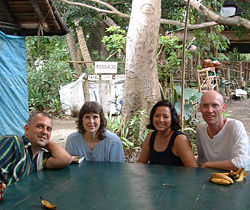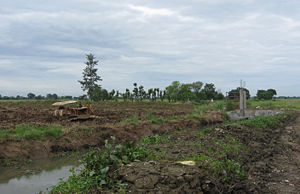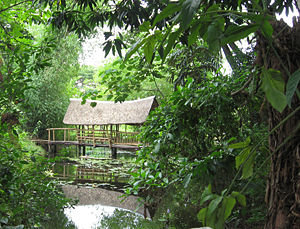"Heartbeat" Ecovillage
From Ecovillages
In April, 2009 I had the honor of traveling to the Philippines to be an instructor in the first Ecovillage Design Education (EDE) course held there. EDE courses, hosted in ecovillages and sustainability education courses worldwide, are projects of Gaia Education, a program of Global Ecovillage Network (GEN).
|
This first EDE in the Philippines was sponsored by Happy Earth, an environmental education organization set up by my friend Penelope Reyes, a fellow speaker at the Japanese Ecovillage Conference in 2007. (See “Eco-Heroes” in Japan in the May, 2008 issue.) Happy Earth is one of three cofounders of Pintig Ecovillage, which Penelope described at the conference. So it was a great pleasure, a year and a half later, to actually stand on the grounds of this nearly 10-acre (4-hectare) site and imagine its future. |
Once developed, Pintig Ecovillage will use traditional bamboo architecture like these buildings at Center for Ecozoing Living and Learning (C.E.L.L.) in the Philippines. Pintig cofounder Penelope Reyes, left.
|

|
Pintig (which means “heartbeat” in Tagalog), is the first ecovillage in the Philippines. It’s located in Cabio, in the province of Nueva Ecija, 90 kilometers north of Manila on the island of Luzon. The other two ecovillage cofounders are Cabiokid Foundation, a permaculture teaching center on an adjacent property in Cabiao, and the Center for Ecozoic Living and Learning (C.E.L.L), an educational center for teaching Thomas Berry’s Universe Story, located in Silang, in the province of Cavite, about 30 kilometers south of Manila.
|
“The purpose of the ecovillage is to create a meaningful community of ecologically-aware people living in harmony with nature,” Penelope says. “We envision ecovillage members as being committed to sustainable living, the protection of the bioregion, and willing to practice some degree of self-sufficiency in local food production.” Inspired by the teachings of Thomas Berry, which call for everyone to become protectors and enhancers the environment, the nonprofit founders see Pintig Ecovillage as a way to encourage people to once again feel reverence and joy for life and nature.
|
Right now the 10-acre property is a flat and nearly treeless area which until recently was a rice field. Because of the copious rain and richly fertile volcanic soil of the region, Pintig’s founders expect it to soon become as lush and species-diverse as the Cabiokid Foundation next door, which, before its founding in 2002 was a flat and treeless rice field too. (Trees along the border of Cabiokid, shown in the photo below, have grown to 50 feet in those few years.) When I visited the Pintig property, the founders had just completed the earth-moving portion of building their initial infrastructure, creating a bridge, roads, and digging future ponds and waterways. |
|
| The site plan calls for a maximum of 12 households arranged in a circle around small pond. (See Pintig aerial photo, below.) Most of Pintig’s common land will be dedicated to productive forest or growing and raising food, through rice paddies, vegetable gardens, and livestock such as chickens and goats. Ecological features will include native Filipino bamboo architecture (like that used on the grounds of C.E.L.L.) small-scale renewable energy technology, and a conscious design that considers possible adaptations to potential future flooding and drought conditions. |
|
“This experimental site is a humble attempt to showcase adaptation to climate change and self-reliance in an appropriate local scale, and do so in a developing country,” Penelope says. “We want to explore how the shift to sustainable living can help alleviate poverty and at the same time ease the strain on the fragile ecosystems in our tropical country.” |
|
Pintig Ecovillage is being financed by grants, internal funding, and, in the future, income-producing social enterprises owned by members. It will feature right livelihoods through supporting fair-trade coffee and bamboo crafts. “Someday we hope to create our own local community currency,” Penelope says.
She and her partner John Vermullen, who emigrated to the Philippines from South Africa, plan to open the Laughing Fish, a bed and breakfast adjacent to the Pintig property. I'll be returning to the Philippines in September, 2010, to teach in another EDE course. I can’t wait to see Pintig’s progress! |
Diana Leafe Christian is publisher and editor of Ecovillages newsletter.













